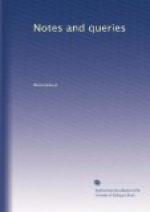EFFESSA.
Camels in Gaul.—The use of camels by the Franks in Gaul is more than once referred to by the chroniclers. In the year 585, the treasures of Mummolus and the friends of Gondovald were carried from Bordeaux to Convennes on camels. The troops of Gontran who were pursuing them—
“invenerunt camelos
cum ingenti pondere auri atque argenti, sive
equos quos fessos per vias
reliquerat”—Greg. Turon.,
l. vii. c. 35.
And after Brunichild had fallen into the hands of Chlotair, she was, before her death, conducted through the army on a camel:—
“Jubetque eam camelum
per omnem exercitum sedentem
perducere.”—Fredegarius,
c. 42.
By what people were camels first brought into Gaul? By the Romans; by the Visigoths; or by the Franks themselves?
R.J.K.
* * * * *
QUERIES.
BIBLIOGRAPHICAL QUERIES.
(Continued from page 325.)
(13.) Is it not a grievous and calumnious charge against the principal libraries of England, Germany, and France, that not one of them contains a copy of the Florentine Pandects, in three folio {422} volumes, “magnifice, ac pereleganter, perque accurate impressis,” as Fabricius speaks? (Bibl. Graec. xii: 363.) This statement, which may be but a libel, is found in Tilgner (Nov. lib. rar. Collect. Fascic. iv. 710.), Schelhorn (Amaen. Lit. iii. 428.), Vogt (Catal. p. 562. Hamb. 1738), and Solger (Biblioth. i 163.). According to the last writer, the edition in question, Florent. 1553, (for a fac-simile of the letters of the original MS. see Mabillon’s Iter Italicum, p. 183.) is,—“splendidissima, et stupendae raritatis, quae in tanta est apud Eruditos aestimatione ut pro 100 Imperialibus saepius divendita fuerit.” Would that the race of such purchasers was not extinct! In Gibbon’s notice of this impression (Decline and Fall, iv. 197. ed. Milman), there are two mistakes. He calls the editor “Taurellus” instead of Taurellius; and makes the date “1551”, when it should have been 1553. These errors, however, are scarcely surprising in a sentence in which Antonius Augustinus is named “Antoninus.” The Archbishop of Tarragona had received a still more exalted title in p. 193., for there he was styled “Antoninus Augustus.” Are these the author’s faults, or are they merely editorial embellishments?
(14.) In what year was the improved woodcut of the Prelum Ascensianum used for the first time? And has it been observed that the small and separated figures incised on the legs of this insigne of Jodocus Badius may sometimes be taken as a safe guide with reference to the exact date of the works in which this mark appears? As an argument serving to justify the occasional adoption of this criterion




